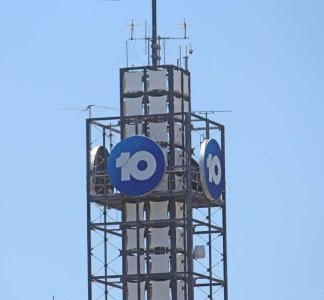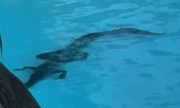Aussie TV braces for seismic shift as Network 10 faces uncertain future amid industry turmoil
- Replies 24
The Australian television landscape is facing a seismic shift that could see the traditional trio of commercial broadcasters reduced to a duo, or perhaps even a solo act, by the end of this decade.
Network 10, once a staple of Aussie screens, is now embroiled in what industry experts are calling ‘serious turmoil’, casting serious doubt over its future as the nation's third commercial broadcaster.
The challenges facing Network 10 are multifaceted and severe. Plummeting program ratings, a crisis in advertising revenue, and a convoluted ownership battle at its American parent company, Paramount Global, have all contributed to the network's precarious position.
The announcement of the cancellation of popular reality shows The Masked Singer and The Bachelor on Monday signalled further trouble for the company, raising doubts about its future existence.

According to Queensland University of Technology Professor Amanda Lotz, who leads the Transforming Media Industries research program, it's unlikely that Australia will continue to have three free-to-air commercial networks in the near future.
‘I would suspect by the end of the decade that we will have two commercial broadcasters,’ Professor Lotz speculated.
‘It’s just math. We’re now in a death spiral. And eventually, it might be that we just have one.’
QUT Professor Anna Potter, an expert in digital media and cultural studies, echoed this sentiment, saying the television industry is currently stretched to the point where television businesses are no longer financially viable.
‘I think there’s a big question, too, about whether Australia can support three television (commercial) broadcasters—and I’m not sure we can,’ she said.
However, according to media analyst Steve Allen, Pearman Director of Strategy and Research, Ten's complicated ownership issues have almost overshadowed the network's inability to significantly increase its audience share, along with the increasingly disrupted advertising market.
‘A new owner of Paramount Global is unlikely to see Ten as an asset worth retaining because the business is in serious turmoil,’ he stated.
‘There’s no programming momentum and they haven’t found a really solid anchor for prime time, their revenue looks steady but they can’t seem to significantly reduce overheads, and now there’s upheaval in terms of their US ownership.’
‘Network 10 is in a real pickle and I don’t see a way out for them,’ Mr Allen added.
Paramount, the parent company of Ten, has been engaged in the ongoing extensive merger and acquisition negotiations in the United States.
Paramount's assets include Paramount Pictures, CBS, Nickelodeon, MTV, Channel 5, and Network 10 in Australia. It is chaired by Shari Redstone, who had been seeking to sell her family's controlling stake in the media conglomerate.
Production company Skydance, led by David Ellison, had been in talks to acquire the Redstone family's shares, but reports suggested dissatisfaction among shareholders with the offer, valued at approximately $US3 billion ($A4.53 billion).
As of Friday, May 3, exclusivity in talks with Skydance ended, opening up discussions with other interested parties.
Major shareholders advocated for considering a rival bid from Apollo Global and Sony Pictures, offering $US26 billion ($A39.26 billion) for a complete acquisition of Paramount Global.
Media industry veteran James Manning, publisher of Mediaweek and seasoned media commentator, expressed uncertainty about Ten's future.
‘Some think whoever the new Paramount owner turns out to be, they will be mainly interested in the studio business, the US CBS network, and the US cable channels,’ Mr Manning wrote in a recent column.
‘Other assets might be sold off. Those could include the Paramount+ streaming business and the free streaming business Pluto TV in the US. International assets to be sold off could include Australia’s Network 10 and UK’s Channel 5.’
He suggested that a private equity firm might be the most probable purchaser of Ten, attracted by a ‘bargain buy’.
Professor Potter concurred, stating, ‘My feeling is that it’s probably not an asset worth holding.’
The decline of Network 10 is symptomatic of broader industry trends. In 2006, Australia's three commercial networks shared a whopping $7.7 billion in advertising revenue.
Fast-forward to the 2020-2021 period, and that figure more than halved to $3.8 billion, according to the Interactive Advertising Bureau.
Television's share of the ad market shrunk from almost half in 2007 to just 18 per cent today.
‘The pot of ad money hasn’t increased, but the places companies can spend it has,’ Professor Lotz said.
‘Too much money has come out of commercial TV.’
‘We live in a very different world now and if we had two services, or maybe just even one that had enough money to have a full slate of programming that could gather a significant audience, that might be better for Australia,’ she added.
Professor Lotz also explained that substantial revenue losses compelled commercial networks to ‘cut back their content so much that people can’t find much they want to watch’.
‘All that’s left is sports, news and reality. The idea that having three commercial players doing virtually the same thing is harder to justify,’ she continued.
Ten's news division never significantly challenged Seven and Nine, and it is no longer a major competitor in live sports broadcasting.
Additionally, according to her, a plethora of media substitutes, such as social media, along with dominant streaming platforms like Netflix and Amazon Prime entering the advertising arena, are diverting viewer attention away from traditional broadcast television.
‘That’s only likely to make things worse for commercial TV operators,’ she pointed out.
Locally, Ten faced a series of internal shake-ups, adding to its instability.
The departure of one of its co-bosses, Jarrod Villani, earlier this year, left Beverley McGarvey, who was appointed as the network’s president and Paramount’s regional lead for Australia and New Zealand, as the sole leader.
Content misfires and legal battles, such as the Bruce Lehrmann defamation action, have further tarnished the network's image.
Ten successfully defended the lawsuit but received criticism from the Federal Court for its handling of several issues related to the broadcast of The Project's interview with Brittany Higgins in 2021.
The court case garnered daily headlines, overshadowing several major content initiatives, many of which did not result in a significant ratings boost.
Warner Brothers, the producers of The Masked Singer, had been in talks with Ten about renewing the show, which is costly to produce.
The proposed deal also included rights to The Bachelor and its spin-offs; however, by passing on The Masked Singer, Ten lost the opportunity to acquire both.
‘That’s a really big hole in their schedule,’ Professor Potter said.
When contacted for comment, a spokesperson from Network 10 stated that the decision to cancel The Bachelor and The Masked Singer was not related to Paramount Global's ownership.
‘We regularly review our programming schedule and consider changes to meet industry and audience trends and is a normal part of our local business operations,’ they commented.
However, in an additional statement, the spokesperson wrote, ‘As a member of a global business, we are used to speculation about our company, but Paramount Australia is a strong diversified media and entertainment business spanning linear free-to-air TV, multi-channels, FAST channels, BVOD with 10 Play, SVOD with Paramount+ as well as consumer products, branded content, live events and more.’
‘On free-to-air, our content slate has had strong results with 10 securing four of the top 10 shows of the year in the key advertising demographics of 25 to 54s and 16 to 39s with Australian Survivor, I’m A Celebrity…Get Me Out Of Here!, Gogglebox and MasterChef Australia.’
‘Plus, these shows have all set new records in digital viewing on 10 Play.’
‘In April, 10 Play had its biggest month ever off the back of strong results in 2023 as the fastest-growing BVOD in Australia. And Paramount+ continues to be the fastest growing streaming service in the country since launching more than two years ago.’
‘We’re confident of our position in the market and are looking forward to an equally strong second half of the year,’ they added.
Last week, Paramount Global CEO Bob Bakish departed from the company amid rumoured disagreements with Ms Redstone and was succeeded by three co-CEOs.
‘The office of the CEO is working with the board to develop a comprehensive, long-range plan to accelerate growth and develop popular content, materially streamline operations, strengthen the balance sheet, and continue to optimise the streaming strategy,’ a statement read.
An email sent to employees from the trio shortly after the announcement warned of ‘challenging’ times ahead.
Experts in the US anticipated this will likely involve further job cuts, in addition to the 800 global redundancies announced in February.
While Ten staff were expected to be impacted, specific details on the number were not disclosed.
According to Bloomberg, the new CEOs are considering various measures beyond cost cuts and restructuring, including the potential sale of ‘non-core assets’ such as its struggling Australian network.
Last year marked Ten's worst ratings ever, with viewers switching to rivals Seven and Nine, as well as streaming platforms like Netflix.
Its total audience share was approximately half of the other two commercial broadcasters, and it even fell behind ABC, solidifying its position as the country's fourth most-watched free-to-air network.
Furthermore, none of the top 50 highest-rated shows of 2023, in terms of total audience, aired on Ten or its streaming and on-demand platforms.
There were also rumours that Paramount+'s premium streaming service—which is active in Australia—might merge with NBC Universal's Peacock platform.
Since its launch in early 2021, Paramount+ has experienced significant financial losses worldwide.
The uncertainty surrounding Paramount's future soured billionaire investor Warren Buffett's perception, leading his company Berkshire Hathaway to sell its entire 15 per cent stake in the company, as he informed shareholders over the weekend.
‘It was 100 per cent my decision, and we’ve sold it all, and we lost quite a bit of money,’ Mr Buffet admitted.
Financial analysts in the United States estimated losses of around $US1.5 billion ($A2.26 billion).
Amidst the turmoil engulfing Network 10 and its uncertain future as Australia's third commercial broadcaster, there's a buzz surrounding the arrival of a purported 'game-changing' streaming platform in the Australian media landscape.
As the fate of traditional broadcasters hangs in the balance, the emergence of new digital players signals a shifting tide in how Australians consume their media content.
 What are your thoughts on Ten’s future? Do you have a favourite show aired by them? Let us know in the comments below!
What are your thoughts on Ten’s future? Do you have a favourite show aired by them? Let us know in the comments below!
Network 10, once a staple of Aussie screens, is now embroiled in what industry experts are calling ‘serious turmoil’, casting serious doubt over its future as the nation's third commercial broadcaster.
The challenges facing Network 10 are multifaceted and severe. Plummeting program ratings, a crisis in advertising revenue, and a convoluted ownership battle at its American parent company, Paramount Global, have all contributed to the network's precarious position.
The announcement of the cancellation of popular reality shows The Masked Singer and The Bachelor on Monday signalled further trouble for the company, raising doubts about its future existence.

Experts said Network 10 is in ‘serious turmoil’ due to failing programs, declining ratings, an advertising revenue crisis, and parent company issues. Credits: Shutterstock
According to Queensland University of Technology Professor Amanda Lotz, who leads the Transforming Media Industries research program, it's unlikely that Australia will continue to have three free-to-air commercial networks in the near future.
‘I would suspect by the end of the decade that we will have two commercial broadcasters,’ Professor Lotz speculated.
‘It’s just math. We’re now in a death spiral. And eventually, it might be that we just have one.’
QUT Professor Anna Potter, an expert in digital media and cultural studies, echoed this sentiment, saying the television industry is currently stretched to the point where television businesses are no longer financially viable.
‘I think there’s a big question, too, about whether Australia can support three television (commercial) broadcasters—and I’m not sure we can,’ she said.
However, according to media analyst Steve Allen, Pearman Director of Strategy and Research, Ten's complicated ownership issues have almost overshadowed the network's inability to significantly increase its audience share, along with the increasingly disrupted advertising market.
‘A new owner of Paramount Global is unlikely to see Ten as an asset worth retaining because the business is in serious turmoil,’ he stated.
‘There’s no programming momentum and they haven’t found a really solid anchor for prime time, their revenue looks steady but they can’t seem to significantly reduce overheads, and now there’s upheaval in terms of their US ownership.’
‘Network 10 is in a real pickle and I don’t see a way out for them,’ Mr Allen added.
Paramount, the parent company of Ten, has been engaged in the ongoing extensive merger and acquisition negotiations in the United States.
Paramount's assets include Paramount Pictures, CBS, Nickelodeon, MTV, Channel 5, and Network 10 in Australia. It is chaired by Shari Redstone, who had been seeking to sell her family's controlling stake in the media conglomerate.
Production company Skydance, led by David Ellison, had been in talks to acquire the Redstone family's shares, but reports suggested dissatisfaction among shareholders with the offer, valued at approximately $US3 billion ($A4.53 billion).
As of Friday, May 3, exclusivity in talks with Skydance ended, opening up discussions with other interested parties.
Major shareholders advocated for considering a rival bid from Apollo Global and Sony Pictures, offering $US26 billion ($A39.26 billion) for a complete acquisition of Paramount Global.
Media industry veteran James Manning, publisher of Mediaweek and seasoned media commentator, expressed uncertainty about Ten's future.
‘Some think whoever the new Paramount owner turns out to be, they will be mainly interested in the studio business, the US CBS network, and the US cable channels,’ Mr Manning wrote in a recent column.
‘Other assets might be sold off. Those could include the Paramount+ streaming business and the free streaming business Pluto TV in the US. International assets to be sold off could include Australia’s Network 10 and UK’s Channel 5.’
He suggested that a private equity firm might be the most probable purchaser of Ten, attracted by a ‘bargain buy’.
Professor Potter concurred, stating, ‘My feeling is that it’s probably not an asset worth holding.’
The decline of Network 10 is symptomatic of broader industry trends. In 2006, Australia's three commercial networks shared a whopping $7.7 billion in advertising revenue.
Fast-forward to the 2020-2021 period, and that figure more than halved to $3.8 billion, according to the Interactive Advertising Bureau.
Television's share of the ad market shrunk from almost half in 2007 to just 18 per cent today.
‘The pot of ad money hasn’t increased, but the places companies can spend it has,’ Professor Lotz said.
‘Too much money has come out of commercial TV.’
‘We live in a very different world now and if we had two services, or maybe just even one that had enough money to have a full slate of programming that could gather a significant audience, that might be better for Australia,’ she added.
Professor Lotz also explained that substantial revenue losses compelled commercial networks to ‘cut back their content so much that people can’t find much they want to watch’.
‘All that’s left is sports, news and reality. The idea that having three commercial players doing virtually the same thing is harder to justify,’ she continued.
Ten's news division never significantly challenged Seven and Nine, and it is no longer a major competitor in live sports broadcasting.
Additionally, according to her, a plethora of media substitutes, such as social media, along with dominant streaming platforms like Netflix and Amazon Prime entering the advertising arena, are diverting viewer attention away from traditional broadcast television.
‘That’s only likely to make things worse for commercial TV operators,’ she pointed out.
Locally, Ten faced a series of internal shake-ups, adding to its instability.
The departure of one of its co-bosses, Jarrod Villani, earlier this year, left Beverley McGarvey, who was appointed as the network’s president and Paramount’s regional lead for Australia and New Zealand, as the sole leader.
Content misfires and legal battles, such as the Bruce Lehrmann defamation action, have further tarnished the network's image.
Ten successfully defended the lawsuit but received criticism from the Federal Court for its handling of several issues related to the broadcast of The Project's interview with Brittany Higgins in 2021.
The court case garnered daily headlines, overshadowing several major content initiatives, many of which did not result in a significant ratings boost.
Warner Brothers, the producers of The Masked Singer, had been in talks with Ten about renewing the show, which is costly to produce.
The proposed deal also included rights to The Bachelor and its spin-offs; however, by passing on The Masked Singer, Ten lost the opportunity to acquire both.
‘That’s a really big hole in their schedule,’ Professor Potter said.
When contacted for comment, a spokesperson from Network 10 stated that the decision to cancel The Bachelor and The Masked Singer was not related to Paramount Global's ownership.
‘We regularly review our programming schedule and consider changes to meet industry and audience trends and is a normal part of our local business operations,’ they commented.
However, in an additional statement, the spokesperson wrote, ‘As a member of a global business, we are used to speculation about our company, but Paramount Australia is a strong diversified media and entertainment business spanning linear free-to-air TV, multi-channels, FAST channels, BVOD with 10 Play, SVOD with Paramount+ as well as consumer products, branded content, live events and more.’
‘On free-to-air, our content slate has had strong results with 10 securing four of the top 10 shows of the year in the key advertising demographics of 25 to 54s and 16 to 39s with Australian Survivor, I’m A Celebrity…Get Me Out Of Here!, Gogglebox and MasterChef Australia.’
‘Plus, these shows have all set new records in digital viewing on 10 Play.’
‘In April, 10 Play had its biggest month ever off the back of strong results in 2023 as the fastest-growing BVOD in Australia. And Paramount+ continues to be the fastest growing streaming service in the country since launching more than two years ago.’
‘We’re confident of our position in the market and are looking forward to an equally strong second half of the year,’ they added.
Last week, Paramount Global CEO Bob Bakish departed from the company amid rumoured disagreements with Ms Redstone and was succeeded by three co-CEOs.
‘The office of the CEO is working with the board to develop a comprehensive, long-range plan to accelerate growth and develop popular content, materially streamline operations, strengthen the balance sheet, and continue to optimise the streaming strategy,’ a statement read.
An email sent to employees from the trio shortly after the announcement warned of ‘challenging’ times ahead.
Experts in the US anticipated this will likely involve further job cuts, in addition to the 800 global redundancies announced in February.
While Ten staff were expected to be impacted, specific details on the number were not disclosed.
According to Bloomberg, the new CEOs are considering various measures beyond cost cuts and restructuring, including the potential sale of ‘non-core assets’ such as its struggling Australian network.
Last year marked Ten's worst ratings ever, with viewers switching to rivals Seven and Nine, as well as streaming platforms like Netflix.
Its total audience share was approximately half of the other two commercial broadcasters, and it even fell behind ABC, solidifying its position as the country's fourth most-watched free-to-air network.
Furthermore, none of the top 50 highest-rated shows of 2023, in terms of total audience, aired on Ten or its streaming and on-demand platforms.
There were also rumours that Paramount+'s premium streaming service—which is active in Australia—might merge with NBC Universal's Peacock platform.
Since its launch in early 2021, Paramount+ has experienced significant financial losses worldwide.
The uncertainty surrounding Paramount's future soured billionaire investor Warren Buffett's perception, leading his company Berkshire Hathaway to sell its entire 15 per cent stake in the company, as he informed shareholders over the weekend.
‘It was 100 per cent my decision, and we’ve sold it all, and we lost quite a bit of money,’ Mr Buffet admitted.
Financial analysts in the United States estimated losses of around $US1.5 billion ($A2.26 billion).
Amidst the turmoil engulfing Network 10 and its uncertain future as Australia's third commercial broadcaster, there's a buzz surrounding the arrival of a purported 'game-changing' streaming platform in the Australian media landscape.
As the fate of traditional broadcasters hangs in the balance, the emergence of new digital players signals a shifting tide in how Australians consume their media content.
Key Takeaways
- Network 10 is experiencing significant turmoil due to failing programs, sliding ratings, an advertising revenue crisis, and troubles within its parent company.
- Experts predicted that by the end of the decade, Australia might have only two free-to-air commercial broadcasters due to the sustainability challenges faced by Network 10.
- The possible sale of Ten's parent company, Paramount Global, complicated matters further, with potential new owners likely not valuing Ten as a worthwhile asset.
- Paramount Global was reportedly considering the sale of 'non-core assets', which could include Network 10, as part of a strategic plan to restructure and cut costs amidst a competitive and changing media landscape.








